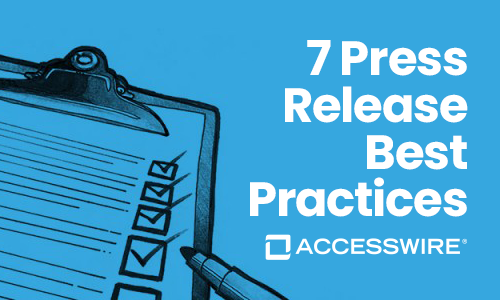A Healthcare PR Guide
Healthcare is not an industry for which a standardized public relations campaign exists. Think about all the sub-categorized businesses that can fit under the oversized healthcare organization: Non-profit and for-profit hospital systems, walk-in clinics, private practices, medical equipment, pharmaceuticals, biotechnology, medical software, supplies, insurance, diagnostic labs, dental offices, elderly and memory care residences, palliative and rehabilitative facilities, advocacy groups, imaging, in-home care, EMT and paramedic services, research…the list goes on and on.
As wide-ranging and diverse as the healthcare industry’s dozens of segments are, there are some tried-and-true methods under which most, if not all, healthcare-related businesses can properly promote themselves. This guide will look at some of these healthcare public relationspractices that corporate communications pros should use in developing their PR strategy, regardless of categorization.
The first point for healthcare marketing professionals to understand is how personal healthcare decisions are – particularly when it comes to which facilities or physicians to go to. Healthcare facilities and physicians/dentists should focus on traditional local and/or regional marketing, advertising, public event sponsorships, and PR initiatives. The exceptions to that rule fall under appearances at industry gatherings, C-Level hires or appointments, medical breakthroughs, or any other times when there is news to share that may hold interest for national or international audiences.
That said, the following suggestions for healthcare-related businesses support your company in ways that expensive marketing and advertising don’t quite cover.
Define Your Objectives and Expectations
As your PR department sits down for the initial meeting that will lead to a well-thought-out strategy, your first order of business will be making a list – a realistic one – of your public relations objectives (which should begin with “Improve Brand Awareness), and the expectations the leadership has for what constitutes success.
Beginning with this exercise will help your team keep track of the campaign, allowing you to reach milestones through deadlines and measure your company’s growth along the way.
Whether you keep the campaign in-house or hire a PR agency, the five questions you should answer in this goal-setting phase are:
- What are your exact goals?
- What length of time and amount of money do you plan on spending on your PR campaign?
- Does your team or chosen agency have enough resources to reach your goals?
- What KPI metrics will you use to measure your campaign’s communication success?
- What is the timeline for meeting your campaign goals?
Once you have solid answers to each of these questions, you will be ready to begin the real work. Try to remember, as you are setting the answers, that you’ll need to target realistic journalists/media outlets that will be able to help with news coverage, so be sure to do the research on the front-end. If this is your company’s first-ever digital marketing campaign, be patient, don’t expect to receive front-page news your first time out of the gate.
Content Is [Still] King…Bow Down Accordingly
With all the algorithms floating around these days, it’s impossible to keep up with every minuscule change to the SEO formula of the week that allows your business to show up on the first page of an organic search. That’s why you need to take a critical look at the content you’re putting onto your website.
Written Content
If you aren’t offering your visitors useful, up-to-date, educational content that will benefit your visitors, then you need to concentrate on improving your website’s content early in your healthcare PR campaign.
To be clear, the content you develop for your website isn’t something you want to pass off to an intern or an admin. Depending on what kind of segment your company operates in, you need a writer with a healthcare or medical experience who can create meaningful content, and he or she should consistently be writing and uploading compelling blog posts about trends, guidelines, legal changes, and everything else that’s related to the sector of healthcare your company works in.
Quality healthcare communications should not resemble a sales pitch, even though you should ensure the website blog is written for your target audience …and always make sure your sales team or business development staffers share your business’s informative blog posts to woo new customers.
Remember: When the content you produce is of high quality, people will share it with their coworkers or friends. Additionally, when you marry informative content with charts, graphics, or other relevant images that add to the storytelling, the odds of getting your content noticed and shared increase dramatically. In fact, try to develop at least one infographic with every blog post…infographics are more likely to be shared than any other type of content.
Video Content
Aside from the written word, video is another way to get noticed – and adding videos to your website improves your organic search traffic. One way of upping your video content game is to interview your company’s CEO or a member of a medical staff about topics that will resonate with your audience. Be sure you mic up your subject, so he or she can be heard. You can also host online events, like Lunch & Learns, that you can upload to your website.
Luckily, there are numerous routes to take when distributing your communications strategy.
Traditional and Digital PR
The old standbys of print (newspapers, magazines, trade publications, etc.) are always a great way to increase your healthcare company’s brand awareness; sticking with these media outlets, however, takes time and patience; additionally, it is sometimes hard to measure KPIs with traditional methods; that’s where Digital PR comes in to play. By promoting your healthcare business online, you will be able to chart click-through rates (CTR), website visitors, social media likes and followers, email campaigns, podcasts, and ratings.
Press release distribution, particularly to trade publications, is arguably the best approach to media coverage, especially if your healthcare-related company is just beginning to develop a PR marketing strategy. Here, you will have a direct line to media outlets that have a vested interest in learning about your healthcare business and what you have to say.
Email Campaigns
Which outlets and/or journalists should you contact when launching email campaigns, and what should you communicate to them? As stated earlier, you want to reach out to those in the healthcare media space who can help you gain exposure for your brand and have them share your information with a larger audience. Easy peasy, right?
Well…
That was easier to do when the Internet was brand new. These days, though, outlets are inundated with companies looking for attention. That’s why our advice is to be as creative as possible in your outreach. Always try to put an interesting spin on your e-correspondence…try to be as unique as possible while also giving your audience something to think about that they hadn’t known before you contacted them. Those who send out the same “blah-blah-blah” messaging will be left in the dust.
Whenever you reach out, make sure you are making the message PERSONAL –– use the recipient’s name (using programs like HubSpot will facilitate that automatically for you).
Originality!
There seems to be an underlying theme about everything in this blog, or maybe it’s downright obvious. Either way, in your efforts to build a great healthcare PR campaign, the bottom line is originality. You need to stand out in a crowded field of boring messages.
That’s where storytelling comes into play.
The one thing that healthcare-related businesses have at their disposal is a plethora of amazing stories to tell: Stories of people whose lives have been changed, helped, and enriched by whatever tools or services your company provides.
Think of all the different angles with which your healthcare company can tell a story. There is no other industry for which storytelling can be as captivating, moving, and resonant than healthcare…so tell those stories! Ask your customers and patients whom you have helped directly to tell their stories through your company’s or practice’s lens.
You have at your disposal the one thing that every other PR professional in other industries wishes they had: Unique, moving stories that can create an emotional connection in people. It is a superpower. Take advantage of that!
What better way to tell your amazing stories than through press releases? Thankfully, ACCESSWIRE is ready to help you do just that, 24/7/365, no matter where in the world your healthcare PR originates. With a press release, you can intertwine stories with facts, figures, numbers, images, charts, and everything else you need to provide a compelling reason to feature your healthcare business. ACCESSWIRE offers press release distribution without surprise fees, and access to the most broad-based media outlets in the world. To get started, simply contact us by clicking here to request a demo!
Similar Blog Posts
PRODUCTS
ACCESSWIRE | All Rights Reserved




